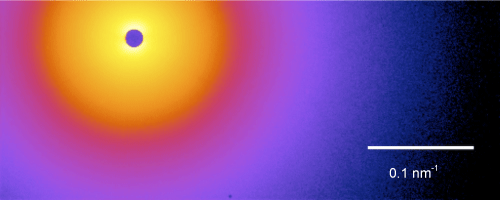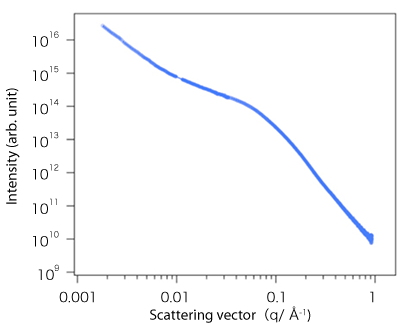Establishment of Four-Dimensional (4D) Nano Design, a Technology for the Development of New Materials Used for High-Performance and High-Quality Tires
- Release Date
- 12 Dec, 2011
- BL03XU (Advanced Softmaterial)
- BL20XU (Medical and Imaging II)
- BL40B2 (Structural Biology II)
Sumitomo Rubber Industries, Ltd.
Japan Synchrotron Radiation Research Institute (JASRI)
The Earth Simulation Center of Japan Agency for Marine-Earth
Science and Technology (JAMSTEC)
Advanced Softmaterial Beamline Consortium
The University of Tokyo
National Defense Academy of Japan
Scientists of Sumitomo Rubber Industries, Ltd., succeeded in developing a technique for precisely measuring the three-dimensional (3D) arrangement of silica nanoparticles in rubber using the high-brilliance X-rays of SPring-8 and an earth simulator and fuel-efficient tires by applying the obtained results on the 3D arrangement to a simulation for designing new materials to be used for high-performance and high–quality tires. This study was carried out in cooperation with scientists from the University of Tokyo, the National Defense Academy of Japan, the Advanced Softmaterial Beamline Consortium, the Earth Simulation Center of JAMSTEC, and JASRI. With the background of increasing worldwide concern over global environmental problems, the required performances for automobile tires have been diversified and become more stringent. At the G8 Summit held in Toyako, Hokkaido, in 2008, it was reported by the International Energy Agency (IEA) in their final report "Fuel-Efficient Road Vehicle Non-Engine Components" that approximately 80% of energy consumed for transportation is attributable to automobiles and that approximately 20% of fuel energy is consumed in overcoming the rolling resistance of tires, indicating that the widespread use of fuel-efficient tires is necessary. The Ministry of Land, Infrastructure, Transport and Tourism and the Ministry of Economy, Trade and Industry established the Council for the Promotion of Fuel-Efficient Tires in 2009, and in January 2010, a labeling system was introduced for summer tires used by domestic automobiles. Thus, the development of fuel-efficient tires is very important from the viewpoint of the global environment, and the development and promotion of technologies related to fuel-efficient tires are strongly desired. Grip performance is realized owing to the energy loss due to the deformation of a tire as a result of its contact with a road surface. Therefore, the two contradictory requirements, i.e., improving the fuel efficiency and grip performance, should be balanced by advanced methods. In this study, the research group developed the technique of time-resolved two-dimensional ultrasmall-angle X-ray scattering (2D-USAXS)*1 with a camera length of 160 m using the high-brilliance X-rays of the Medical and Imaging Beamline II (BL20XU) of SPring-8. The two types of high-precision data obtained by time-resolved 2D-USAXS and time-resolved two-dimensional small-angle X-ray scattering (2D-SAXS)*2 using the BL03XU Advanced Softmaterial Beamline (FSBL; a beamline dedicated for use by the Advanced Softmaterial Beamline Consortium that was completed in 2010) and the Structural Biology Beamline II (BL40B2) were analyzed by the two-dimensional pattern reverse Monte Carlo method (2Dp-RMC)*3 developed using an earth simulator. Using the results of this study, the research group succeeded in developing a both-ends-modified polymer in cooperation with Sumitomo Chemical Co., Ltd., which was used to develop fuel-efficient tires (Fig1). The rolling resistance of the tires was reduced by approximately 39% (approximately 6% less fuel consumption in JC08 mode) and the wet grip performance was improved by approximately 9% compared with those of conventional tires manufactured by Sumitomo Rubber Industries, Ltd. |
<<Glossary>>
*1 Time-resolved two-dimensional ultrasmall-angle X-ray scattering (2D-USAXS)
Time-resolved 2D-USAXS is a method for analyzing the size and shape of structures in a material, which are larger than approximately 100 nm. Measurement using time-resolved 2D-USAXS with a camera length of approximately 160 m is possible using the high-brilliance and highly parallel X-rays of SPring-8. Also, this method enables in situ time-resolved measurement of the structural changes in a material subjected to an external field.
*2 Time-resolved two-dimensional small-angle X-ray scattering (2D-SAXS)
Time-resolved 2D-SAXS is a method for analyzing the size and shape of structures in a material, which are smaller than approximately 100 nm. This method, in combination with the high-brilliance X-rays of SPring-8, enables in situ time-resolved measurement of the structural changes in a material subjected to an external field.
*3 Two-dimensional pattern reverse Monte Carlo method (2Dp-RMC)
The reverse Monte Carlo method is used to analyze the structure of materials with an isotropic scattering pattern of amorphous structures such as liquid metals. For rubber, the analysis of the entire 2D scattering patterns (or at least, the first quadrant) is necessary to analyze the anisotropic scattering pattern, requiring a huge amount of calculation. The research group developed superparallel codes for 2Dp-RMC, which is an extended version of the reverse Monte Carlo method obtained using an earth simulator to accommodate 2D scattering patterns, and applied the codes for the analysis of anisotropic 2D scattering patterns.
<<Figures>>
and one-dimensional scattering profile obtained by
superimposing 2D-USAXS and 2D-SAXS images (lower)
structures and rolling resistance (fuel efficiency)
|
For more information, please contact: Japan Agency for Marine-Earth Science and Technology (JAMSTEC) |
- Previous Article
- Discovery of New Mechanism of Drug Extrusion by Multidrug Efflux Proteins, a Cause of Multidrug-Resistant Bacterial Infection (Press Release)
- Current article
- Establishment of Four-Dimensional (4D) Nano Design, a Technology for the Development of New Materials Used for High-Performance and High-Quality Tires









